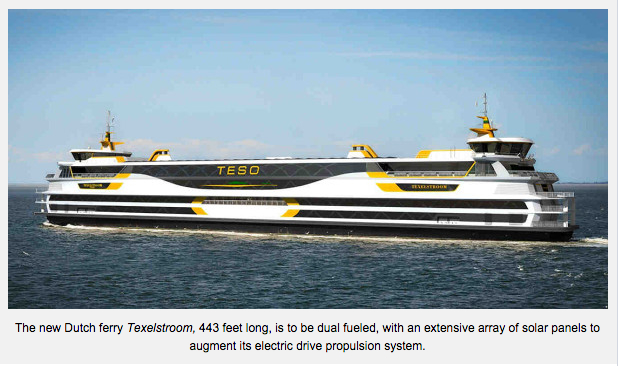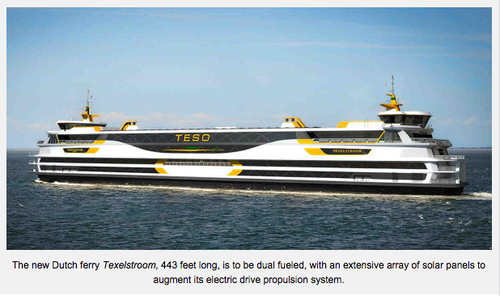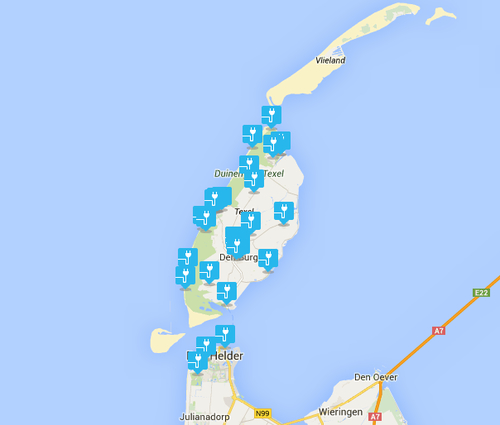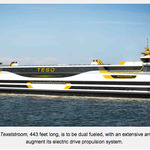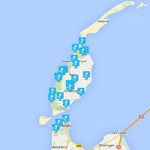Ferry service
A new ferry connecting Texel with the mainland in Den Helder has been ordered from the Spanish shipyard LaNaval. This new ferry will eventually replace the current ferry Dokter Wagemaker, holding about 1750 passengers and 300 cars with a length of 130 m (TESO). The new ferry Texelstroom (figure 2.4.1) will be 443 feet long (135 m) and will be able to transport about 1750 passengers and 350 cars (LaNaval). Texelstroom will have dual fuel engines to be powered by either diesel oil or compressed natural gas. In addition, a back-up system of Corvus ion batteries will be used to increase efficiency. In case of emergency, the ferry can be run on the battery power alone. The new ferry will also have about 700 m2 solar panels to decrease the use of fossil fuels. The design of the ferry is double ended, so that maneuvering turns in Den Helder and Texel should not be necessary (Piellisch, 2014). According to an article on the website C-JOB, the new ferry was to be designed to fit more cars than the old ferry. The design dilemma was to try to keep the size of the ferry small while making room for more cars. Texelstroom will be delivered to Teso (Texels Eigen Stoomboot Onderneming) in the autumn of 2015, and will be taking passengers from early spring 2016 (C-JOB).
Teso is continuously working with making their water transport more sustainable (TESO). They were part of a trial in 2007 using the diesel fuel GTL (“Gas To Liquids”), which is natural gas converted to liquid diesel fuel. The exhaust fumes from GTL contain less harmful substances than pure diesel oil. Teso has also been using a type of diesel fuel containing a low level of sulphur, which leads to less dangerous emissions. Lastly, Teso has been experimenting with adding X-MILE to their fuel. X-MILE contains enzymes that makes the fuel last longer; experiments on Dokter Wagemaker have shown that as much as 6-7 % less fuel have been used, resulting in about 300 000 liters of diesel saved. These saved liters also contribute to lower emission of CO, NOx and soot (TESO).
Figure 2.4.1. The new ferry Texelstroom. Source: (Piellisch, 2014)
Electric cars
Urgenda, a company working with different sustainability projects, together with New Motion, a company providing charging stations for electric vehicles, are working on a project for Texel regarding electric cars; “Texel Gastvrij Elektrisch Vervoer” (“Texel Hospitable Electric Transportation”). Texel municipality was chosen to be one of 9 trials for electric vehicles projects in the Netherlands. According to Urgenda, around 50 electric vehicles were driving on the island in early 2013 and around 19 public charging locations on the island were in use. Figure 2.4.2 shows that there might have been an increase in charging stations since 2013, although not all the charging stations on the map are public, some are reserved to customers (Urgenda).
Urgenda and New Motion are doing investigations on what is needed to make the whole island of Texel only dependent on electric vehicles. What are the barriers? How do stakeholders react? How can the effect of the batteries contribute? To spread the knowledge about the Texel hospitable electric transportation, workshops and seminars have been arranged. The electric vehicles have also been present in large events on the island, such as Texel half marathon and Round Texel (Urgenda).
An electric car is a car run by an electric motor powered by a battery, and not a combustion engine. The battery can be charged on various locations around the world. Modern pure electric cars have a range of about 80-90 miles (130-145 km), although it varies a lot per model (Plugincars).
Figure 2.4.2. Map of charging poles on Texel. Source: (Chargemap)
Public transport and electric bikes
On Texel there are 140 km of bicycle paths. Bikes can be brought on the ferry, but there are also around 12 places on the island where bikes can be rented (Texel). Many of the rental places also have electric bikes for rent. Electric bikes, or e-bikes, are bikes with an electric motor run by a battery (ebikes). E-bikes function just as normal bikes, with the advantage that riding will be easier and faster due to the extra “push” from the electric motor. Most motors will recharge the battery when the pedals are running at a higher pace than the motor itself can reach. E-bikes let people who for multiple reasons do not chose the bike as a means of transport enjoy the benefits of biking, without the drawbacks. Drawbacks can be having to shower at work, feeling too tired, not getting to the destination quick enough etc. Currently, legislation can affect the speed limits for electric bikes, and this differs from location to location. Safety has to be considered, however, the positive benefits with riding faster can be illegal with some legislation (ebikes).
ebikes write on their website that e-bikes actually have a smaller ecological footprint than regular bikes (ebikes). The explanation for this is that normal bikes are powered by humans, and humans are in turn powered by metabolism, where the fuel is the food we eat. This food is currently grown with harmful fertilizers and transported long distances to reach us around the world. The net efficiency is very low. Consider then that the bikes are powered mostly by the help of electricity and stored in a battery, the efficiency is much higher. Also considering manufacturing and recycling of the battery; e-bikes can be seen as consuming around 2 to 10 times less fossil fuel than regular bikes. Of course a lot of assumptions has to be made in such a calculation, but the general idea presents an interesting future for the e-bike (ebikes).
TEMO (Texels Own Mobility Organization), worked with several manufacturers in producing an innovative bicycle (Global Islands Networks, 2014). The aim of this motivation was to produce a bike which would be supplied with an electrical fuel cell. Based on the assumption that there will be sufficient loading stations, grid connected or stands alone, situated around the 140 km of dedicated bike paths; then cycling can be easier for greater distances with less effort. Thus, the bike would be an attractive mean of transportation, particularly for elderly people and those who are less mobile. A bike rack suitable for hanging onto the back of buses and taxis was also suggested. In this way, the rental shops could offer a service whereby cyclists can be picked up by a bus or taxi, for whatever reason e.g. bad weather or strong headwinds. Tourists would then be more likely to choose cycling as a mode of transport when assured of getting back home.
A new pilot bus service will be taken into service in December 2014. This so called Texelhopper will be a mix between a regular bus service and a taxi. The Texelhopper will provide a service with more frequent stops than the regular busses. Travelers need to request their trip one hour in advance and indicate where they want to embark and where they need to get off again (Texelhopper).
3D printing
A technology that should be taken into consideration, is the evolution of 3D printing. Since Texel is a small and self-sustaining community, it could be an interesting test location for things such as 3D printing.
With 3D printing, entire parts of the supply chain will be erased and there will be a decreased demand for transport services. Especially for islands such as Texel, that want to become more sustainable and self-sufficient, this is therefore an interesting technology to adopt. Before we are at mass scale adoption of this technology though, we will first have to go through three phases (Berman, 2011).
During the first phase it is mainly the designers and architects that use 3D printers to make prototypes. Most of the prints that are made are either these prototypes, or components of a much bigger design that still needs finishing. Currently we are in this stage and 3D printing therefore does not offer plenty of benefits for Texel and its inhabitants. This phase is followed by the 2nd phase, which encompasses the increase of printing of finished goods. Some scientists expect that by 2020, half of the goods that roll out of 3D printers will be finished goods. The third and last phase, is the one where mass adoption takes place and the average joe will own a 3D printer, just like most families right now have at least one desktop printer at home. This will most probably happen between 2020 and 2030 and once this happens, the shopping and transport business will change. There will be an increased demand for the transportation of filament (the resource of the 3D printer) and a decreased demand for the transportation of bigger goods that consists of multiple parts which a 3D printer can print itself. Once the 3D printing technology and the drone technology are established, the municipality of Texel could even think about drastic measures such as the prohibition of heavy traffic such as trucks, since everything can be 3D manufactured on site.
Hydrogen infrastructure
Starting from next year (2015), car producers will start manufacturing hydrogen driven cars. It is therefore not ruled out that in the coming decades, this technology can emerge and tourists, as well as Texelaars, want to make use of this technology. If that is the case, Texel should facilitate the technical system to be able to use this technology.
General trends in tourism
Figure 2.4.3. Society change from industrial to network. Source: (Richards, 2011)
Some general trends in tourism includes the transition from an industrial society to a networking society. This means that collaboration and co-operation become increasingly important, see figure 3 (Richards, 2011). Another trend is that local and rural places are becoming more interesting to visit, since tourists want to be unique in the choices of travel spots. Exotic travel to far-away destinations has become mainstream among tourists, and therefore it is more exciting to visit local spots (Richards, 2011). The fact that many trips nowadays are booked online, and that research on destinations also takes place online, makes the internet an important parameter when discussing tourism. Increasing amounts of forums online where restaurants and hotels can be discussed relate to the trend of a network society (Richards, 2011). Storytelling is also becoming the 21st century's most important marketing technique. Richards (2011) has an example in his article where he explains that cars are not only a means for transport, but also tells us something about the owner. Relating this to tourism; cities and towns need to create a narrative that can be sold to tourists. Maybe the future mobility system on Texel could be part of its narrative, to increase tourism?
References
Berman, B. (2011). 3-D printing: The new industrial revolution. Hempstead, NY, Frank G. Zarb School of Business, Hofstra University.
Chargemap. Chargemap. Collected from Chargemap: http://chargemap.com/ the 29th of November 2014
C-JOB. Texelstroom. Collected from C-JOB: http://www.c-job.eu/en-GB/50/texelstroom.html the 29th of November 2014
ebikes. Intro to ebikes. Collected from ebikes: http://www.ebikes.ca/learn/intro-to-ebikes.html the 29th of November 2014
LaNaval. Press Release Lanaval New Ferry Texelstroom TESO Texel. Collected from Scribd: http://www.scribd.com/doc/223040478/Press-Release-Lanaval-New-Ferry-Texelstroom-TESO-Texel the 29th of November 2014
Piellisch, R. (den 22 August 2014). Corvus Lithium ESS for Texelstroom ferry. Collected from HHP Insight: http://hhpinsight.com/cng/2014/08/corvus-lithium-ess-for-texelstroom-ferry/ the 29th of November 2014
Plugincars. Cars. Collected from Plugincars: http://www.plugincars.com/cars?sort_by=field_epa_range_value&sort_order=DESC the 29th of November 2014
Richards, G. (2011). Tourism trends: Tourism, culture and cultural routes. Collected from http://www.academia.edu/1473475/Tourism_trends_Tourism_culture_and_cultural_routes the 20th of December 2014
TESO. TESO and sustainability. Collected from TESO: https://www.teso.nl/en/about-teso/teso-and-sustainability the 29th of November 2014
Texel. Transport. Collected from Texel: http://www.texel.net/en/directory/transport%23search-P1A0B4C0S0#search-P1A0B4C0S0 the 29th of November 2014
Urgenda. TEXEL GASTVRIJ ELEKTRISCH VERVOER. Collected from Urgenda: http://www.urgenda.nl/themas/mobiliteit/elektrischvervoeroptexel/ the 29th of November 2014
Texelhopper. About Texelhopper. Collected from Texelhopper: https://www.texelhopper.nl/en/about-texelhopper/ the 6th of December 2014
